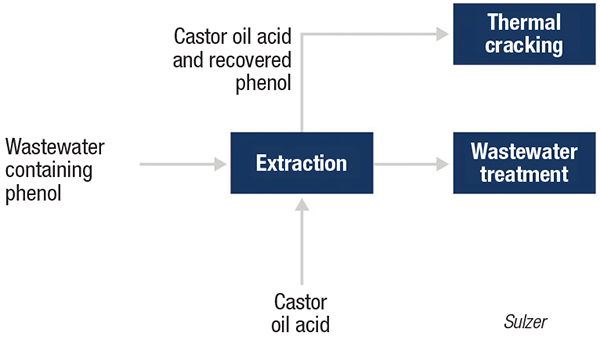Many industrial processes involve phenol, but its toxic nature means that it must be effectively removed from waste streams prior to any subsequent biological treatment steps. Phenol can be removed via evaporation, but this method is quite energy-intensive. Alternatively, the phenol content may be transformed into phenolates for removal, but this process requires a number of intermediate steps that increase costs.
 Sulzer Chemtech Ltd. (Winterthur, Switzerland; www.sulzer.com) recently unveiled a solvent-based liquid-liquid extraction (LLE) process for treating phenol-laden wastewater from sebacic acid production (diagram). In the manufacture of sebacic acid, castor oil is hydrolyzed to form ricinoleic acid, which undergoes an alkali fusion-cracking step in the presence of phenol and sodium hydroxide, resulting in a phenol-rich wastewater stream. Employing Sulzer’s ECR agitated column in the LLE scheme, the process removes phenol using ricinoleic acid, which is already used as a reagent to form sebacic acid, thus eliminating the need for additional solvents, as well as solvent-recovery systems. Furthermore, the phenol extracted from the wastewater is reutilized in the alkali fusion-cracking stages of the process, reducing the demand for “virgin” phenol. This creates a closed-loop, circular system, where both ricinoleic acid and phenol re-enter the process flow. This technology marks the first commercial application of ECR columns for LLE of phenol from wastewater using ricinoleic acid.
Sulzer Chemtech Ltd. (Winterthur, Switzerland; www.sulzer.com) recently unveiled a solvent-based liquid-liquid extraction (LLE) process for treating phenol-laden wastewater from sebacic acid production (diagram). In the manufacture of sebacic acid, castor oil is hydrolyzed to form ricinoleic acid, which undergoes an alkali fusion-cracking step in the presence of phenol and sodium hydroxide, resulting in a phenol-rich wastewater stream. Employing Sulzer’s ECR agitated column in the LLE scheme, the process removes phenol using ricinoleic acid, which is already used as a reagent to form sebacic acid, thus eliminating the need for additional solvents, as well as solvent-recovery systems. Furthermore, the phenol extracted from the wastewater is reutilized in the alkali fusion-cracking stages of the process, reducing the demand for “virgin” phenol. This creates a closed-loop, circular system, where both ricinoleic acid and phenol re-enter the process flow. This technology marks the first commercial application of ECR columns for LLE of phenol from wastewater using ricinoleic acid.
In a commercial-scale installation, the system has demonstrated that it can reduce the concentration of phenol in wastewater from 1,000 down to 200 parts per million (ppm). Sulzer says that its ECR system provides efficiencies for LLE because the column can fit an elevated number of theoretical stages into a limited equipment footprint. Also, since the ECR does not rely on mixer-settlers as in typical LLE installations, the need for ancillary equipment is eliminated and energy consumption is reduced. Additionally, the ECR column avoids the creation of emulsions, which can form in the presence of mixer-settlers and create challenges in phase separation. Instead, explains Sulzer, the ECR creates small droplets in a controlled manner to optimize mass transfer and phase separation.